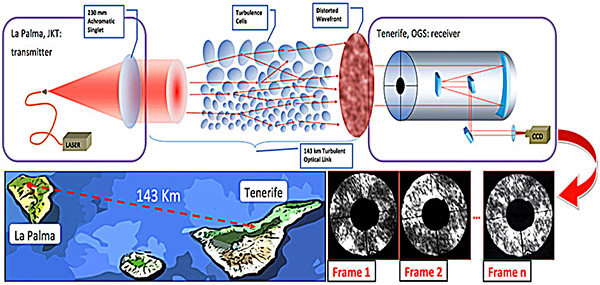In the 60s, the famous "Butterfly Effect" captured the idea that when one deals with a physical system like the terrestrial atmosphere, very tiny perturbations such as the air moved by the tail strokes of a butterfly can lead to very huge consequences like a hurricane in some other place in the world. The terrestrial atmosphere is indeed a physical system ruled by chaotic dynamics
and the motion of local air mass is completely impossible to predict in a regime of strong turbulence.
A team of researchers of the University of Padova led by Professor Paolo Villoresi, has shown that the same mechanism which makes it difficult to forecast the weather conditions can be, however, an interesting resource for Information Technology and Communications (ITC).
The experiment was realised between the telescopes in La Palma and Tenerife. On the roof of the ING's Jacobus Kapteyn Telescope (JKT), Villoresi's group installed the transmitter telescope designed and realised in Padova (aspheric singlet 230 mm f/10) which aims a continuous laser beam to the ESA Optical Ground Station (OGS), 143 km away at the Teide Observatory. The basic idea of the experiment is to exploit the horizontal propagation of light through a random medium, that can be considered as a series of phase screens. Due to the long propagation, phase disturbances transform in amplitude random modulation, which is subsequently phase-modulated again, and so on.
 |
At the transmitter side in La Palma, a lambda = 810 nm laser beam is collimated with a 230 monochromatic singlet, explicitly configured to limit geometrical distortions, and then sent through a 143 km free space optical channel. At the receiver side, at the OGS observatory in Tenerife, the pupil of the Ritchey-Chretien telescope (diameter of 1016 mm) is illuminated by the distorted wave-front and imaged on a high resolution CCD camera. The collected images are suitably analysed and processed so that genuine random numbers are obtained from them. Credit: extracted from Davide G. Marangon, Giuseppe Vallone & Paolo Villoresi, 2014, Scientific Reports, 4, 5490 and licensed under a Creative Commons A-NC-ND Internacional License[1] [ PNG ].
|
By recording at a suitable rate the intensity distribution at the OGS telescope, the Padova team could grasp the randomness of the turbulence. To extract from this a string of genuine random numbers took a further step: by interpreting the centroid distribution of the scintillation peaks in a given frame as a pattern in a large matrix, a single number may be associated with that particular realisation. This is known as the lexicographic index, which is then converted to a binary string. The string was then successfully analysed using stringent tests of random numbers, attesting to their good quality.
Random numbers are indeed the main ingredient of cryptography protocols which makes possible the secure exchange of information, and it is of fundamental importance to find pure physical random processes to generate them.
The authors acknowledge the fruitful collaboration with the Isaac Newton Group of Telescopes, which made available the JKT for the experiment, as well as the IAC and the European Space Agency (ESA) which made available the OGS.
More information:
Davide G. Marangon, Giuseppe Vallone & Paolo Villoresi, 2014, "Random bits, true and unbiased, from atmospheric turbulence", Scientific Reports, 4, 5490 [ Paper ]
Notes:
[1] This work is licensed under a Creative Commons Attribution-NonCommercial-NoDerivs 4.0 International License. The images or other third party material in this article are included in the article's Creative Commons license, unless indicated otherwise in the credit line; if the material is not included under the Creative Commons license, users will need to obtain permission from the license holder in order to reproduce the material. To view a copy of this license, visit http://creativecommons.org/licenses/by-nc-nd/4.0/.



